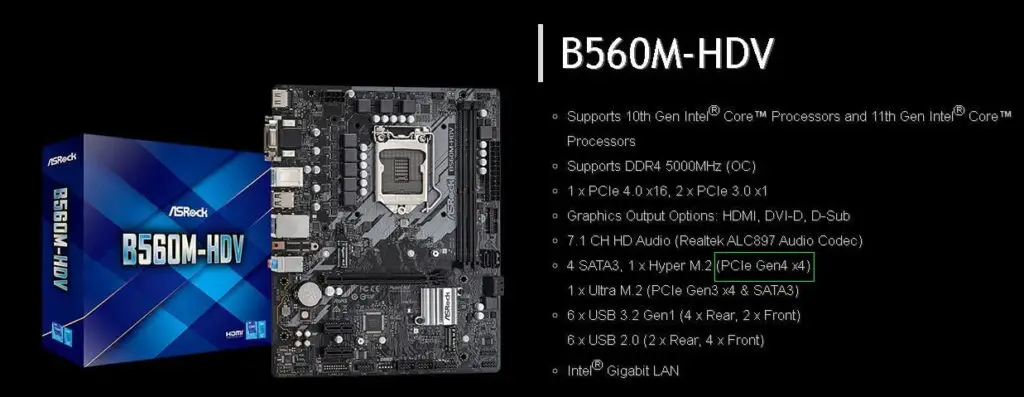We’ve taken the liberty to assemble a list of the best NVMe storage drives on the market, in descending order of speed, and compare their respective values.
Included below are tables showing important metrics; namely, capacity, read speed, write speed, PCIe generation, and dollar cost per gigabyte of storage.
This guide was created for the purpose of making comparisons easy. All included items are of excellent quality, and your decision to purchase one over another should be based primarily on speed and cost. All speeds given are maximums.
PCIe Gen 3 vs Gen 4
Before reading our recommendations, it’s important that you understand the difference between PCIe Gen 3 and Gen 4.
PCIe, or Peripheral Component Interconnect Express as it’s formally known, is an interface used to connect components in a computer. PCIe compatibility is primarily determined by the motherboard and CPU.
PCIe Gen 4 is the most recent iteration of this technology. Latest-generation motherboards tend to have at least one PCIe Gen 4 M.2 slot (meaning they’re compatible with gen 4 NVMes). It supports faster speeds than PCIe gen 3, meaning 4th-gen NVMe drives are able to have faster read and write speeds.
PCIe generations are backwards compatible, but you usually shouldn’t use a PCIe gen 4 drive with a motherboard or processor that only supports gen 3. Your storage drive won’t be able to achieve the speeds it’s rated for because it’s bottlenecked by the limitations of gen 3, so you’d be paying a premium for the same speed as a comparable gen 3 model.
Compatibility:
You can find out whether or not your motherboard supports PCIe gen 4 NVMes pretty easily. Just type in your motherboard’s model and read the specifications from the manufacturer’s website (which should be one of the first results). It will list all slots, and you’ll see the PCIe generation listed next to each one.

As for CPUs, AMD’s 3000 series and up support PCIe Gen 4. Intel’s 11th-gen Rocket Lake CPUs support gen 4, and future generations will presumably do the same.
Now that we’ve got that out of the way, let’s get into what you came for in the first place: Our rankings of the best NVMe storage drives to date.
Best NVMe Storage Drives:
PNY XLR8 CS3140 | Best Drive
| Connection: | M.2 |
| Capacities: | 1TB, 2TB |
| Sequential Read Speed: | 7500 MB/s |
| Sequential Write Speed: | 5650 MB/s |
| PCIe Generation: | Gen 4 |
| Cost ($/GB): | .21 (1TB Model) .20 (2TB Model) |
The CS3140 is the fastest, and most expensive, drive on this list. If you’re looking to build the best PC possible and money is no object, this should be your go-to.
Western Digital Black SN850 | Best 500GB Drive
| Connection: | M.2 |
| Capacities: | 500GB, 1TB, 2TB |
| Sequential Read Speed: | 7000 MB/s |
| Sequential Write Speed: | 5300 MB/s |
| PCIe Generation: | Gen 4 |
| Cost ($/GB): | .24 (500GB Model) .22 (1TB Model) .20 (2TB Model) |
Western Digital’s SN850 is a close second to the PNY CS3140. It wouldn’t be advisable to buy this in 1TB or 2TB capacities, as the CS3140 offers both better price and better performance as these thresholds. If you’re looking to buy a smaller 500GB drive, however, this is where the WD Black shines, as it is available in a smaller size, and is therefore the fastest 500GB storage drive.
Samsung 980 PRO| Best 250GB Drive
| Connection: | M.2 |
| Capacities: | 250GB, 500GB, 1TB, 2TB |
| Sequential Read Speed: | 6900 MB/s |
| Sequential Write Speed: | 5100 MB/s |
| PCIe Generation: | Gen 4 |
| Cost ($/GB): | .32 (250GB Model .25 (500GB Model) .20 (1TB Model) .22 (2TB Model) |
The 980 Pro is a lightning-fast drive. It’s speed comes at a premium, so it’s probably overkill for most systems. It’s priced very similarly to the CS3140, so I would recommend spending the extra $10 for the 9 and 10% increase and read and write speeds, respectively. The 980 PRO is still worth noting for its 250GB model, however, which is the fastest of its size on the market.
PNY XLR8 CS3030 | Best PCIe Gen 3 NVMe/Best Value
| Connection: | M.2 |
| Capacities: | 250GB, 500GB, 1TB, 2TB |
| Sequential Read Speed: | 3500 MB/s |
| Sequential Write Speed: | 3300 MB/s |
| PCIe Generation: | Gen 3 |
| Cost ($/GB): | .16 (250GB Model) .13 (500GB Model) .11 (1TB Model) .12 (2TB Model |
The CS3030 is, by far, our favorite storage drive; we use it in almost all of our builds of the month. It offers incredible performance and storage per dollar. This is the best choice for the majority of computers, unless you’re on a very tight budget or going for the absolute fastest performance with no regard for cost.
Crucial P5 | Honorable Mention
| Connection: | M.2 |
| Capacities: | 250GB, 500GB, 1TB, 2TB |
| Sequential Read Speed: | 3400 MB/s |
| Sequential Write Speed: | 3000 MB/s |
| PCIe Generation: | Gen 3 |
| Cost ($/GB): | .24 (250GB Model) .12 (500GB Model) .11 (1TB Model) .14 (2TB Model) |
The Crucial P5 is definitely worth mentioning in a list of the best storage drives. It is 100MB/s slower than the 970 EVO, one of Samsung’s most popular drives, but its write speed is 20% faster and it’s significantly cheaper. We would still recommend the CS3030 over the P5 at their current price points, but if you can find the P5 on sale, its performance is very close to that of the CS3030 and may offer better value.